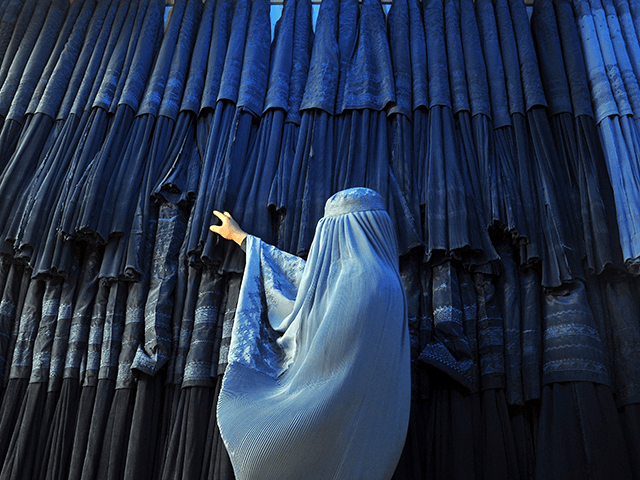Burqa sales have surged in Afghanistan since the Taliban terror group seized control of the country last month, an Afghan burqa merchant told Al Arabiya on Thursday.
Al-Arabiya, a Saudi outlet, said it visited a store selling burqas in Afghanistan on September 2, though it did not reveal in which city or province the shop was located. The Saudi news site interviewed one of the boutique’s customers, a woman identified only as Nadia, who said she felt compelled to purchase the item after the Taliban, a jihadist group based on a strict interpretation of Sunni Islam, deposed Afghanistan’s U.S.-backed government in Kabul on August 15.
A burqa is a full-body garment that covers even the wearer’s eyes. The Taliban made burqas mandatory during its prior reign in Afghanistan – though the Quran does not require it – but has claimed that, this time, hijab, or hair coverings, will suffice.
“In the previous government, I was wearing a hijab or other suitable clothes,” Nadia told Al Arabiya.
“Now I want to buy a burqa because after the arrival of the Taliban, they said that women should observe the veil,” she said.
The Taliban has traditionally required girls and women in Afghanistan to wear a burqa — which covers a woman’s entire body from head to toe and includes a mesh fabric screen for her eyes — in public areas of Afghanistan it controls. The hardline Sunni group previously governed Afghanistan from 1996-2001, when it formally ordered all females to fully cover themselves in a burqa during public outings in accordance with Islamic law, or sharia. The Taliban confirmed to Reuters on August 17 it plans to govern Afghanistan through a system of sharia moving forward, meaning it is almost certain to reimpose its historic covering policy for women and girls nationwide.
Taliban spokesman Suhail Shaheen told the U.K.’s Sky News on August 17 the group would not force Afghan women to don a burqa in public.
“The burqa is not the only hijab that (can) be observed, there is different types of hijab not limited to burqa [sic],” Shaheen told Sky News at a press conference in Kabul.
Shaheen’s use of the word “hijab” is notable, as the Arabic term may be interpreted as an umbrella label for a woman’s modest dress in accordance with Islam. In this sense, the word hijab could be used to refer to any garment that covers any amount of a woman’s body. A hijab is most widely known as a veil that generally covers a woman’s head. The garment may also conceal some of a woman’s face, hair, and parts of her upper body, depending on how it is worn.
Fabric sellers in Kabul told Pajhwok Afghan News on August 22 the general sale and price of hijabs in the capital city had increased “with the return of Taliban rule in the country.”
“In the past, I could sell four or five hijabs a day, but now I sell 15 to 17 of them after the return of Taliban,” a hijab merchant in Kabul told Pajhwok.
Another Kabul shopkeeper named Niamatullah told the Afghan news site he previously sold one hijab “for 1,000 afghanis but now it was sold for 1,200 afghanis.”
“Before the Taliban’s return, I would sell from six to seven hijabs a day, but now I sell up to 20 a day,” Niamatullah said.

COMMENTS
Please let us know if you're having issues with commenting.